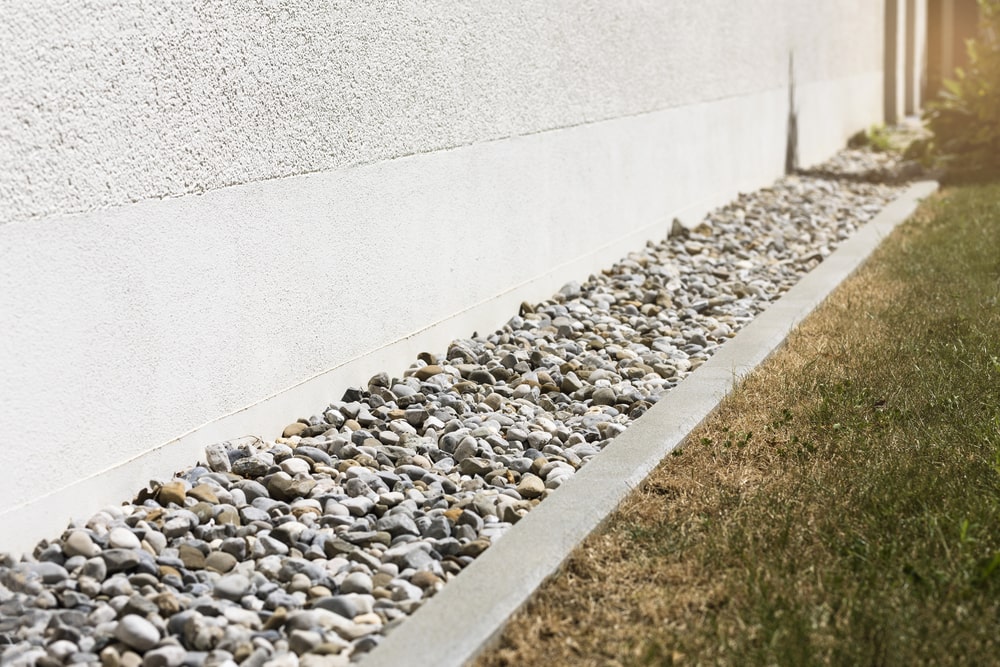Looking to save some money by tackling your yard’s drainage issues yourself? Proper drainage is essential to prevent water damage, protect your home’s foundation, and keep your yard healthy. While installing a drainage system can be a significant project, it’s entirely manageable—especially when you have your landscaping supplies conveniently delivered right to your driveway for free. Here’s a closer look at five effective DIY drainage solutions and generally how to implement them, although you should do much more research if you decide to build one of these projects and not use this blog as a how to guide.
French Drains
French drains are one of the most effective ways to redirect excess water away from your home and other vulnerable areas in your yard. These drains consist of a trench filled with gravel and a perforated pipe that collects and channels water away.
How to Install a French Drain:
- Choose the Right Location: Identify the low spots in your yard where water tends to pool and determine the best route to direct it away.
- Dig the Trench: The trench should be at least 12 inches deep and slope downward (about 1 inch for every 10 feet) to encourage water flow.
- Lay Landscaping Fabric: Line the trench with landscape fabric to prevent soil from clogging the drain over time.
- Add Gravel and Pipe: Place a layer of gravel at the bottom, then lay the perforated pipe with the holes facing downward. Cover with more gravel.
- Cover the Drain: Fold over the excess landscape fabric and cover with additional soil or decorative stone.
French drains are excellent for managing water runoff from patios, driveways, and heavily saturated areas.
Dry Wells
If your yard experiences frequent flooding or standing water, a dry well may be the best solution. A dry well is an underground structure that temporarily stores excess water and slowly releases it into the surrounding soil.
Steps to Build a Dry Well:
- Select the Location: Position the dry well at a lower elevation than your home to encourage water flow.
- Dig a Large Pit: The well should be at least 3 feet deep and wide enough to hold a high volume of water.
- Install a Drainage Pipe (Optional): A drainage pipe can be connected from gutters or other water collection points to direct water into the dry well.
- Line the Well with Gravel: Fill the bottom with coarse gravel to improve water infiltration.
- Place a Dry Well Tank or Container: You can use a prefabricated dry well container or create a makeshift one using a large plastic barrel with drilled holes.
- Backfill with Gravel and Soil: Surround the dry well with more gravel and cover with soil to keep it hidden.
Dry wells are particularly useful for areas with poor drainage where water tends to sit for extended periods.
DIY Drainage Project #3: Sump Pumps
A sump pump is the most powerful solution for severe drainage problems, particularly if you experience basement flooding or excessive yard flooding. A sump pump actively removes water and directs it to a safer discharge location.
Installing a Sump Pump in Your Yard:
- Determine the Lowest Point: The sump pump should be installed at the lowest area of your yard where water accumulates.
- Dig a Sump Pit: The pit should be at least 2 feet deep and wide enough to accommodate the pump basin.
- Place the Pump in the Pit: Install the sump pump inside a plastic sump basin to protect it from clogging.
- Connect the Discharge Pipe: The pipe should lead water at least 10-20 feet away from your home.
- Ensure Power Supply: Sump pumps require electricity, so ensure a safe power connection with a waterproof outdoor outlet.
- Test the System: Pour water into the pit to activate the pump and ensure proper drainage.
While sump pumps are more costly and require electricity, they offer a reliable and immediate solution to standing water issues.
Curtain Drains
A curtain drain is similar to a French drain but is shallower and works well for moving surface water away from low-lying areas.
Steps to Create a Curtain Drain:
- Identify the Drainage Path: Find the best route to channel water away from the problem area.
- Dig a Shallow Trench: A curtain drain trench should be around 6-12 inches deep and slope away from the property.
- Add a Perforated Pipe: Lay the pipe in the trench to collect and redirect water.
- Surround with Gravel: Fill the trench with gravel to improve drainage and prevent clogging.
- Cover with Filter Fabric: This helps keep the drain clear of debris and soil over time.
Curtain drains are excellent for preventing water from pooling in specific yard areas and can be used alongside French drains for enhanced effectiveness.
Elevate the Yard
If you prefer a more natural approach, elevating the problem area with topsoil and mulch can help prevent water accumulation.
How to Raise Low Areas:
- Assess the Yard: Identify the spots where water collects and determine how much elevation is needed.
- Add Organic Material: Spread layers of organic mulch, compost, and topsoil to raise the area gradually.
- Level and Compact: Use a rake and tamper to level the new material evenly.
- Plant Vegetation: Planting grass or deep-rooted plants helps improve drainage and prevents erosion.
Elevating the yard is a simple and cost-effective way to handle minor water pooling issues without extensive digging or pipe installation.

